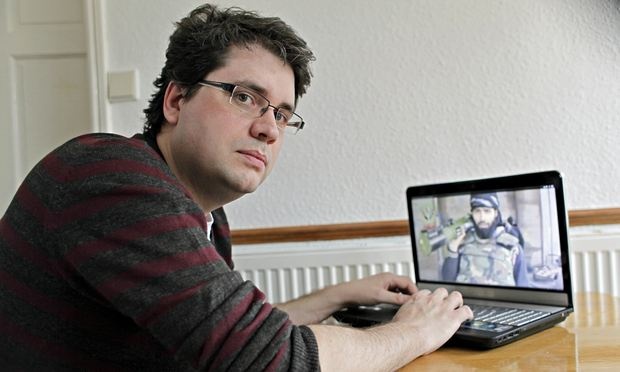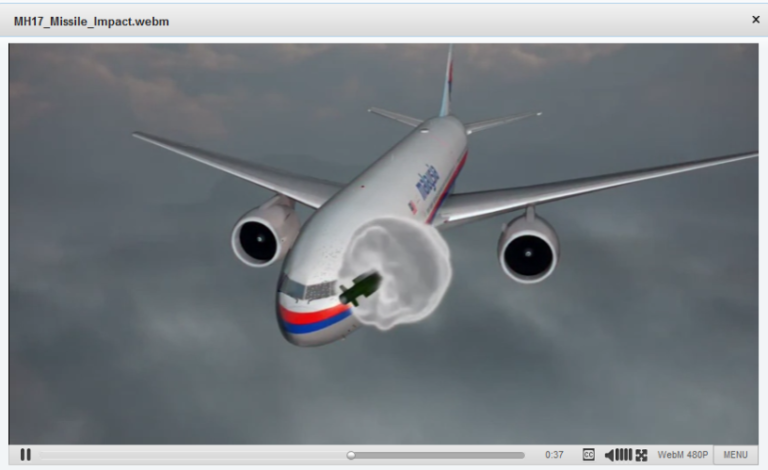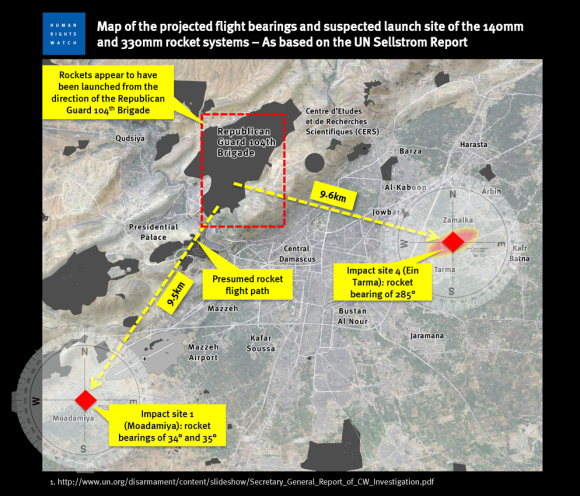Exclusive: In covering the new Cold War, The New York Times has lost its journalistic bearings, serving as a crude propaganda outlet publishing outlandish anti-Russian claims that may cross the line into fraud, reports Robert Parry.
By Robert Parry, ConsortiumNews
In a fresh embarrassment for The New York Times, a photographic forensic expert has debunked a new amateurish, anti-Russian analysis of satellite photos related to the shoot-down of Malaysia Airlines Flight 17 over eastern Ukraine in 2014, labeling the work “a fraud.”
Last Saturday, on the eve of the second anniversary of the tragedy that claimed 298 lives, the Times touted the amateur analysis asserting that the Russian government had manipulated two satellite photos that revealed Ukrainian anti-aircraft missiles in eastern Ukraine at the time of the shoot-down.

The clear implication of the article by Andrew E. Kramer was that the Russians were covering up their complicity in shooting down the civilian airliner by allegedly doctoring photos to shift the blame to the Ukrainian military. Beyond citing this analysis by armscontrolwonk.com, Kramer noted that the “citizen journalists” at Bellingcat had reached the same conclusion earlier.
But Kramer and the Times left out that the earlier Bellingcat analysis was thoroughly torn apart by photo-forensic experts including Dr. Neal Krawetz, founder of the FotoForensics digital image analytical tool that Bellingcat had used. Over the past week, Bellingcat has been aggressively pushing the new analysis by armscontrolwonk.com, with which Bellingcat has close relationships.
This past week, Krawetz and other forensic specialists began weighing in on the new analysis and concluding that it suffered the same fundamental errors as the previous analysis, albeit using a different analytical tool. Given Bellingcat’s promotion of this second analysis by a group with links to Bellingcat and its founder Eliot Higgins, Krawetz viewed the two analyses as essentially coming from the same place, Bellingcat.
“Jumping to the wrong conclusion one time can be due to ignorance,” Krawetz explained in a blog post. “However, using a different tool on the same data that yields similar results, and still jumping to the same wrong conclusion is intentional misrepresentation and deception. It is fraud.”
A Pattern of Error
Krawetz and other experts found that innocuous changes to the photos, such as adding a word box and saving the images into different formats, would explain the anomalies that Bellingcat and its pals at armscontrolwonk.com detected. That was the key mistake that Krawetz spotted last year in dissecting Bellingcat’s faulty analysis.

Krawetz wrote: “Last year, a group called ‘Bellingcat’ came out with a report about flight MH17, which was shot down near the Ukraine/Russia border. In their report, they used FotoForensics to justify their claims. However, as I pointed out in my blog entry, they used it wrong. The big problems in their report:
“–Ignoring quality. They evaluated pictures from questionable sources. These were low quality pictures that had undergone scaling, cropping, and annotations.
“–Seeing things. Even with the output from the analysis tools, they jumped to conclusions that were not supported by the data.
“–Bait and switch. Their report claimed one thing, then tried to justify it with analysis that showed something different.
“Bellingcat recently came out with a second report. The image analysis portion of their report heavily relied on a program called ‘Tungstène’. … With the scientific approach, it does not matter who’s tool you use. A conclusion should be repeatable though multiple tools and multiple algorithms.
“One of the pictures that they ran though Tungstène was the same cloud picture that they used with ELA [error level analysis]. And unsurprisingly, it generated similar results — results that should be interpreted as low quality and multiple resaves. … These results denote a low quality picture and multiple resaves, and not an intentional alteration as Bellingcat concluded.
“Just like last year, Bellingcat claimed that Tungstène highlighted indications of alterations in the same places that they claimed to see alterations in the ELA result. Bellingcat used the same low quality data on different tools and jumped to the same incorrect conclusion.”
Although Krawetz posted his dissection of the new analysis on Thursday, he began expressing his concerns shortly after the Times article appeared. That prompted Higgins and the Bellingcat crew to begin a Twitter campaign to discredit Krawetz and me (for also citing problems with the Times article and the analysis).
When one of Higgins’s allies mentioned my initial story on the problematic photo analysis, Krawetz noted that my observations supported his position that Bellingcat had mishandled the analysis (although at the time I was unaware of Krawetz’s criticism).
Higgins responded to Krawetz, “he [Parry] doesn’t recognize you’re a hack. Probably because he’s a hack too.”
Further insulting Krawetz, Higgins mocked his review of the photo analyses by writing: “all he has is ‘because I say so’, all mouth no trousers.”
Spoiled by Praise
Apparently, Higgins, who operates out of Leicester, England, has grown spoiled by all the praise lavished on him by The New York Times, The Washington Post, The Guardian and other mainstream publications despite the fact that Bellingcat’s record for accuracy is a poor one.

For instance, in his first big splash, Higgins echoed U.S. propaganda in Syria about the Aug. 21, 2013 sarin gas attack — blaming it on President Bashar al-Assad — but was forced to back down from his assessment when aeronautical experts revealed that the sarin-carrying missile had a range of only about two kilometers, much shorter than Higgins had surmised in blaming the attack on Syrian government forces. (Despite that key error, Higgins continued claiming the Syrian government was guilty.)
Higgins also gave the Australian “60 Minutes” program a location in eastern Ukraine where a “getaway” Buk missile battery was supposedly videoed en route back to Russia, except that when the news crew got there the landmarks didn’t match up, causing the program to have to rely on sleight-of-hand editing to deceive its viewers.
When I noted the discrepancies and posted screenshots from the “60 Minutes” program to demonstrate the falsehoods, “60 Minutes” launched a campaign of insults against me and resorted to more video tricks and outright journalistic fraud in defense of Higgins’s faulty information.
This pattern of false claims and even fraud to promote these stories has not stopped the mainstream Western press from showering Higgins and Bellingcat with acclaim. It probably doesn’t hurt that Bellingcat’s “disclosures” always dovetail with the propaganda themes emanating from Western governments.
It also turns out that both Higgins and “armscontrolwonk.com” have crossover in personnel, such as Melissa Hanham, a co-author of the MH-17 report who also writes for Bellingcat, as does Aaron Stein, who joined in promoting Higgins’s work at “armscontrolwonk.com.”
The two groups also have links to the pro-NATO think tank, Atlantic Council, which has been at the forefront of pushing NATO’s new Cold War with Russia. Higgins is now listed as a “nonresident senior fellow at the Atlantic Council’s Future Europe Initiative” and armscontrolwonk.com describes Stein as a nonresident fellow at the Atlantic Council’s Rafik Hariri Center for the Middle East.
Armscontrolwonk.com is run by nuclear proliferation specialists from the Middlebury Institute for International Studies at Monterey, but they appear to have no special expertise in photographic forensics.
A Deeper Problem
But the problem goes much deeper than a couple of Web sites and bloggers who find it professionally uplifting to reinforce propaganda themes from NATO and other Western interests. The bigger danger is the role played by the mainstream media in creating an echo chamber to amplify the disinformation coming from these amateurs.
Just as The New York Times, The Washington Post and other major outlets swallowed the bogus stories about Iraq’s WMD in 2002-2003, they have happily dined on similarly dubious fare about Syria, Ukraine and Russia.

And just as with the Iraq disaster, when those of us who challenged the WMD “group think” were dismissed as “Saddam apologists,” now we’re called “Assad apologists” or “Putin apologists” or simply “hacks” who are “all mouth, no trousers” – whatever that means.
For instance, in 2013 regarding Syria, the Times ran a front-page story using a “vector analysis” to trace the sarin attack back to a Syrian military base about nine kilometers away, but the discovery of the sarin missile’s much shorter range forced the Times to recant its story, which had paralleled what Higgins was writing.
Then, in its eagerness to convey anti-Russian propaganda regarding Ukraine in 2014, the Times even returned to a reporter from its Iraq-falsehood days. Michael R. Gordon, who co-authored the infamous “aluminum tubes” article in 2002 that pushed the bogus claim that Iraq was reconstituting a nuclear weapons program, acceptedsome new disinformation from the State Department that cited photos supposedly showing Russian soldiers in Russia and then reappearing in Ukraine.
Any serious journalist would have recognized the holes in the story since it wasn’t clear where the photos were taken or whether the blurry images were even the same people, but that didn’t give the Times pause. The article led the front page.
However, only two days later, the scoop blew up when it turned out that a key photo supposedly showing a group of soldiers in Russia, who then reappeared in eastern Ukraine, was actually taken in Ukraine, destroying the premise of the entire story.
But these embarrassments have not dampened the Times’ enthusiasm for dishing out anti-Russian propaganda whenever possible. Yet, one new twist is that the Times doesn’t just take false claims directly from the U.S. government; it also draws from hip “citizen journalism” Web sites like Bellingcat.
In a world where no one believes what governments say the smart new way to disseminate propaganda is through such “outsiders.”
So, the Times’ Kramer was surely thrilled to get fed a new story off the Web that claimed the Russians had doctored satellite photographs of Ukrainian Buk anti-aircraft missile batteries in eastern Ukraine just before the MH-17 shoot-down.
Instead of questioning the photo-forensic expertise of these nuclear proliferation specialists at armscontrolwonk.com, Kramer simply laid out their findings as further corroboration of Bellingcat’s earlier claims. Kramer also mocked the Russians for trying to cover their tracks with “conspiracy theories.”
Ignoring Official Evidence

But there was another key piece of evidence that the Times was hiding from its readers: documentary evidence from Western intelligence that the Ukrainian military did have powerful anti-aircraft missile batteries in eastern Ukraine on July 17, 2014, and that the ethnic Russian rebels didn’t
In a report released last October, the Netherlands’ Military Intelligence and Security Service (MIVD) said that based on “state secret” information, it was known that Ukraine possessed some older but “powerful anti-aircraft systems” and “a number of these systems were located in the eastern part of the country.” MIVD added that the rebels lacked that capacity:
“Prior to the crash, the MIVD knew that, in addition to light aircraft artillery, the Separatists also possessed short-range portable air defence systems (man-portable air-defence systems; MANPADS) and that they possibly possessed short-range vehicle-borne air-defence systems. Both types of systems are considered surface-to-air missiles (SAMs). Due to their limited range they do not constitute a danger to civil aviation at cruising altitude.”
Since Dutch intelligence is part of the NATO intelligence apparatus, this report means that NATO and presumably U.S. intelligence share the same viewpoint. Thus, the Russians would have little reason to fake their satellite photos showing Ukrainian anti-aircraft missile batteries in eastern Ukraine if the West’s satellite photos were showing the same thing.
But there is a reason why the Times and other major mainstream publications have ignored this official Dutch government document – because if it’s correct, then it means that the only people who could have shot down MH-17 belong to the Ukrainian military. That would turn upside-down the desired propaganda narrative blaming the Russians.
Yet, that blackout of the Dutch report means that the Times and other Western outlets have abandoned their journalistic responsibilities to present all relevant evidence on an issue of grave importance – bringing to justice the killers of 298 innocent people. Rather than “all the news that’s fit to print,” the Times is stacking the case by leaving out evidence that goes in the “wrong direction.”
Of course, there may be some explanation for how both NATO and Russian intelligence could come to the same “mistaken” conclusion that only the Ukrainian military could have shot down MH-17, but the Times and the rest of the Western mainstream media can’t ethically just pretend the evidence doesn’t exist.
Unless, of course, your real purpose is to disseminate propaganda, not produce journalism. Then, I suppose the behavior of the Times, other MSM publications and, yes, Bellingcat makes a lot of sense.
[For more on this topic, see Consortiumnews.com’s “MH-17: Two Years of Anti-Russian Propaganda” and “NYT Is Lost in Its Ukraine Propaganda.”]








